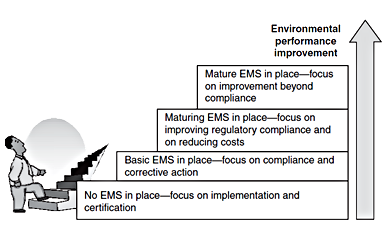The advantages of using an environmental management system include:
- Ensuring a holistic approach to environmental impacts
- Focusing on only critical aspects and processes
- Making use of time-tested, mature approaches recognized worldwide
- Establishing positive relationships with regulators
Economic benefits of implementing an environmental management system or good environmental stewardship that an organization can expect include:
- Corporate reputation and image
- Lower environmentally related costs and fees
- Increased access to new customers
- Direct savings through environmental source reduction
Susan L.K. Briggs discusses the ways to measure and show value of an EMS within an organization in the Quality Progress article, “Do Environmental Management Systems Improve Performance?” In addition to the obvious quantifiable benefits in reductions in pollutant emissions and waste, there are three approaches to measuring improvements within an organization:
- Management system improvement: Qualitative and quantitative improvements to management support processes, such as employee training and awareness, compliance assurance processes, or corrective/preventative action programs
- Organizational reputation: Unquantifiable improvements in an organization’s reputation or improved relations with regulatory bodies, community organizations, or other interested parties
- Financial benefits: Quantitative cost savings or cost avoidance associated with any of the improvements
Since the ISO 14001 standard is non-prescriptive, it is important to understand that an environmental management system is what any organization makes it. If one organization does not realize the expected benefits from its management system, an improvement team should identify the organization’s level of maturity and take the steps needed to proceed to the next level in order to reach the full potential of the environmental management system.
Evolutionary model of Environmental Management System development

The History of Environmental Management Systems
Quality approaches have traditionally maintained a fairly strict focus on business and customer issues, such as reducing defects and waste and improving efficiency, profitability, and customer satisfaction.
Environmental and sustainability goals for quality initiatives are relatively recent. Because the business world is accustomed to treating environmental practices as sources of added costs, the challenge for quality practitioners is to identify where environmental and sustainability quality issues, such as reduction of waste and use of renewable energy, also serve business and customer interests.
The characteristics of each stage in the evolution of compliance management to sustainability:
- 1990 to 1994: Compliance management (CM) meant focusing on regulation and relying on environmental departments to react to issues.
- 1994 to 1998: Environmental management systems (EMS) brought a more systematic, organization-wide focus on environmental issues.
- 1998 to 2002: Environmental information management systems (EIMS) involve using web-based systems and integrating multiple systems.
- 2002 to 2006: Environmental process management systems (EPMS) make use of quality tools, using a project focus to drive improvements.
- 2006 to current: Sustainability requires integrating environmental, social, and economic goals and using best practices to address risk and uncertainty.